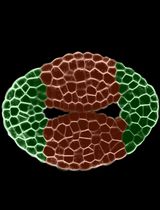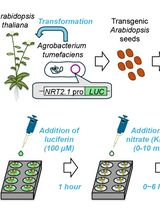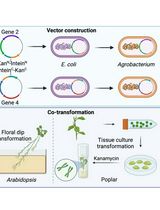- EN - English
- CN - 中文
3’ Rapid Amplification of cDNA Ends (3’ RACE) Using Arabidopsis Samples
对拟南芥样本的cDNA 3'末端进行快速扩增(3' RACE)
发布: 2015年10月05日第5卷第19期 DOI: 10.21769/BioProtoc.1604 浏览次数: 21287
评审: Arsalan DaudiFang XuAnonymous reviewer(s)
Abstract
Production of functional eukaryotic RNA is a very elaborate process that involves a complex interplay between transcription and various RNA processing activities, including splicing, 5’ capping, and 3’ cleavage and polyadenylation (Bentley, 2014). Accurate mapping of RNA ends provides a valuable tool to assess transcriptional and post-transcriptional events giving rise to different gene transcripts. The abundance of such transcripts most likely depends on exogenous and developmental cues, or mutations. In the reference plant Arabidopsis, perturbation of the HUA-PEP post-transcriptional regulatory factors (Rodríguez-Cazorla et al., 2015) leads to the accumulation of aberrant transcripts of the key floral homeotic gene AGAMOUS (AG) (Yanofsky et al., 1990) that retain intronic sequence. It was determined by 3’ RACE reactions that such erroneous transcripts correspond to premature processing and polyadenylation events taking place at the AG intron region. Here we describe a protocol that is suitable for analysis of relatively abundant transcripts and also for detecting aberrant RNA species that are likely prone to rapid turnover. Likewise, the method, here adapted to Arabidopsis reproductive tissues, can be applied to characterize RNA species from other organs (leaf, root) and/or other plant species. We provide a detailed protocol of our 3’ RACE procedure comprising four major parts: Total RNA extraction, RNA amount determination and quality control, the RACE procedure itself, and isolation of the resulting RACE products for cloning and sequencing.
Keywords: Arabidopsis (拟南芥)Materials and Reagents
- Disposable gloves
- Sterile disposable RNase-free pipette tips
- RNase-free microcentrifuge tubes
- Plant sample (Arabidopsis young flower buds, stages 1 through 9)
Note: Arabidopsis flower stages according to Smyth et al., 1990. Other tissue/species can be tested as well. - Liquid nitrogen
- GeneJET Plant RNA Purification Kit (Thermo Fisher Scientific, catalog number: K0801 )
- 1 M DTT (Sigma-Aldrich, catalog number: 43816 )
- Absolute ethanol (JT Baker 8006) and 96% Ethanol (as recommended by the RNA extraction kit manufacturer, see point 6 above)
- 4M LiCl (made in distilled water and autoclaved, not necessarily fresh)
- DNase I, RNase-free (Thermo Fisher Scientific, catalog number: EN0525 )
- RiboLock RNase Inhibitor (Thermo Fisher Scientific, catalog number: EO0382 )
- dNTPs mix 10 mM each (Thermo Fisher Scientific, catalog number: R0192 )
- OligodT-Anchor Primer (Roche 5’/3’ RACE Kit) (Roche Diagnostics, catalog number: 03 353 621 001 , version 10)
- Maxima Reverse Transcriptase + buffer 5x (Thermo Fisher Scientific, catalog number: EP0741 )
- RNase-free water
- High Fidelity PCR Enzyme Mix + buffer 10x (Thermo Fisher Scientific, catalog number: K0191 )
- PCR Anchor Primer (Roche 5’/3’ RACE Kit) (Roche Diagnostics, catalog number: 03 353 621 001 )
- Gene specific 5’ Primer/s (Table 1)
- GeneJET Gel Extraction Kit (Thermo Fisher Scientific, catalog number: K0691 )
- StrataClone PCR Cloning Kit (Agilent Technologies, catalog number: 240205 )
- Taq DNA Polymerase (EURx, catalog number: EK2500-04 )
- GeneRulerTM 100 bp Plus DNA Ladder (Thermo Fisher Scientific, catalog number: SM0321 ) (or any other suitable molecular marker for your convenience)
Equipment
- Mortar and pestle (beaked Haldenwanger mortar, 63 mm. diameter. Clean, autoclave and dry before use)
- Thermomixer (water bath or heat block can be used as well) (Eppendorf)
- Microcentrifuge (Heraeus, Biofuge Pico)
- Refrigerated centrifuge BR15 (B. Braun Melsungen AG) with rotor 12,148-H (Sigma-Aldrich) for 1.5 ml Eppendorf tubes
- BioPhotometer Plus (Eppendorf)
- Thermal Cycler T100 (Bio Rad) (or any other conventional PCR device)
- Electrophoresis system
- UV transilluminator
Procedure
文章信息
版权信息
© 2015 The Authors; exclusive licensee Bio-protocol LLC.
如何引用
Rodríguez-Cazorla, E., Andújar, A., Ripoll, J. J., Bailey, L. J., Martínez-Laborda, A., Yanofsky, M. F. and Vera, A. (2015). 3’ Rapid Amplification of cDNA Ends (3’ RACE) Using Arabidopsis Samples. Bio-protocol 5(19): e1604. DOI: 10.21769/BioProtoc.1604.
分类
植物科学 > 植物分子生物学 > DNA > 基因表达
植物科学 > 植物分子生物学 > RNA > 转录
分子生物学 > DNA > PCR
您对这篇实验方法有问题吗?
在此处发布您的问题,我们将邀请本文作者来回答。同时,我们会将您的问题发布到Bio-protocol Exchange,以便寻求社区成员的帮助。
Share
Bluesky
X
Copy link














